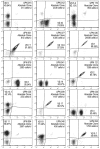Clonal drift demonstrates unexpected dynamics of the T-cell repertoire in T-large granular lymphocyte leukemia
- PMID: 21865345
- PMCID: PMC3204910
- DOI: 10.1182/blood-2011-02-338517
Clonal drift demonstrates unexpected dynamics of the T-cell repertoire in T-large granular lymphocyte leukemia
Erratum in
- Blood. 2012 Aug 30;120(9):1963. His, Eric D [corrected to Hsi, Eric D]
Abstract
T-cell large granular lymphocyte leukemia (T-LGLL) is characterized by chronic lymphoproliferation of cytotoxic T lymphocytes (CTLs) and is associated with lineage-restricted cytopenias. Introduction of T-cell receptor (TCR) variable β-chain (Vβ) monoclonal antibodies has facilitated identification and enumeration of clonal CTLs by flow cytometry. A highly skewed TCR Vβ repertoire identified by flow cytometry is strongly associated with monoclonal CDR3 regions by quantitative sequencing and positive TCRγ rearrangement assays. Therefore, Vβ expansions can serve as surrogate markers of CTL clonality to assess clonal kinetics in T-LGLL. We analyzed the TCR repertoire in 143 patients, 71 of which were available for serial measurements over 6 to 96 months. Although the majority (38/71, 54%) maintained a consistent monoclonal expansion, many (26/71, 37%) unexpectedly displayed a change in the dominant clone, whereby the original CTL clone contracted and another emerged as demonstrated by Vβ typing. Our results demonstrate that the T-cell repertoire is more dynamic in T-LGLL than recognized previously, illustrating the heterogeneity of disorders under this categorization.
Figures





References
-
- Loughran TP., Jr Clonal diseases of large granular lymphocytes. Blood. 1993;82(1):1–14. - PubMed
-
- Lamy T, Loughran TP., Jr Clinical features of large granular lymphocyte leukemia. Semin Hematol. 2003;40(3):185–195. - PubMed
-
- Loughran TP, Jr, Starkebaum G. Large granular lymphocyte leukemia. Report of 38 cases and review of the literature. Medicine. 1987;66(5):397–405. - PubMed
-
- Sokol L, Loughran TP., Jr Large granular lymphocyte leukemia. Oncologist. 2006;11(3):263–273. - PubMed
-
- Wong KF, Yip SF, So CC, Lau GT, Yeung YM. Cytomegalovirus infection associated with clonal proliferation of T-cell large granular lymphocytes: causal or casual? Cancer Genet Cytogenet. 2003;142(1):77–79. - PubMed
Publication types
MeSH terms
Substances
Grants and funding
LinkOut - more resources
Full Text Sources

